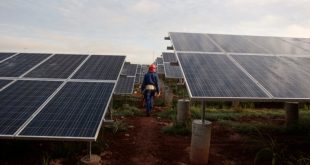The recent discovery of a potentially catastrophic asteroid, 2024 YR4, has generated great concern in Latin America. With Colombia, Ecuador and Venezuela directly on their way, urgent questions arise about the risk of impact, emergency planning and the necessary scientific advances to avoid this cosmic threat.
The asteroid journey and its focus in Latin America
On December 27, 2024, the Chilean Station of the Land Asteroid Impact Alert (Atlas) detected a worrying space rock called 2024 YR4. This early detection indicated that the object was traveling through the solar system with an orbit of approximately 3.99 years. Just two days before his discovery, at Christmas, he had approached the earth at a distance of 515,000 miles, more than double the distance from the earth to the moon, but still relatively close according to astronomical standards.
The reports show that, as of January 31, 2025, the asteroid is located about 30 million miles away. For April of that year, terrestrial telescopes will lose their trace. Astronomers anticipate tracing it again in June 2028, although a precise measurement of its size could continue to be elusive up to at least 2032. According to limited data, scientists believe that 2024 YR4 could measure between 130 and 300 feet (approximately 40 –90 meters) diameter. This wide size estimate leaves a vast range of impact scenarios open.
While an asteroid of this size may not be able to end the world, it could cause severe damage if it collides with our planet. Experts expect that, if the 2024 YR4 impact the earth, it could generate an explosive energy of up to 8 TNT megatons, approximately 500 times stronger than the Hiroshima bomb. Currently, astronomers allocate a 2.3% probability of an impact on Earth on December 22, 2032. Although it may seem small, even a percentage greater than 1% cause alarm in the scientific community. Partly due to their planned travel corridor near Ecuador, the most threatened countries are Colombia, Ecuador, Venezuela and several others that extend from southern Asia to East Africa.
For Latin America, this planned corridor underlines the imminent threat. The cities of Colombia, Ecuador and Venezuela cannot afford to be complacent. If the 2024 YR4 impact a populated region, the loss of lives and destruction could be deep, especially in densely populated urban centers. The scenario reminds the asteroid that exploded over Siberia in 1908, sweeping approximately 770 square miles of forest. An explosion of the size of a city in Latin America would undoubtedly cause a humanitarian crisis. Therefore, the risks are high, and these nations are closely observing developments.
Concerns about size and possible consequences
Scientists determine the diameter of an asteroid partly measuring the amount of light it reflects, which can be misleading if the object is especially bright or extremely dark. Radar -based measurements provide more reliable numbers, but 2024 YR4 will not pass close enough for a precise analysis by radar until much later in the decade. Even then, the passage in December 2028 will remain at a distance of 4.7 million miles, too far for conclusive reading.
Due to the uncertainty around the size of the asteroid, the exact threat it represents remains uncertain. A 130 -foot diameter asteroid could cause an event similar to Tunguska, such as the one in Siberia in 1908. However, an asteroid of 300 feet in diameter could be significantly more destructive. In terms of volume, an asteroid of 300 feet wide has approximately 11 times the volume of an asteroid 130 feet wide, which could climb the impact of a “cities destroyer” to a “major regional catastrophe”.
If the 2024 YR4 impact the Earth, especially in a densely populated region of Colombia, Ecuador or Venezuela, the immediate explosion radius could extend about 30 miles. The nearby areas could suffer devastating shock waves, intense heat and fire. If the ocean impacts, the tsunami could flood coastal cities and force many people to leave their homes. Whatever the situation, the results would challenge the infrastructure and emergency services of these countries. Ecuador and Colombia have mountains; Venezuela has great rivers. Local regions differ significantly. Some topographies could protect the communities of shock waves, but also concentrate the force of landslides or floods similar to a tsunami if the impact generates sufficient seismic energy.
For now, astronomers place 2024 YR4 at a level 3 on the Torino impact danger scale, which goes from 0 to 10. Although level 3 may not seem alarming, it is higher than any other asteroid known today. Once experts refine the path and size of the object, the classification could change, potentially down if the new data reveal that it is smaller or that their trajectory diverts it from the earth. That said, the margin of error remains considerable. If the asteroid tends towards the greater end of the current estimates, the threat level could increase even more.
Current strategies and regional preparation
In 2022, NASA showed a first win in planetary defense: crashing a spacecraft against a distant asteroid to prove if its orbit could be altered. Called the Double Asteroid Redirection Test (Dart), the project confirmed that kinetic impacts can really divert space rocks. This success feeds the hope that, if 2024 YR4 turns out to be truly dangerous, an internationally coordinated mission could divert the asteroid in time. This global cooperation potential before a common threat is a source of hope. However, such effort requires worldwide cooperation and must be executed sufficiently in advance, since last -minute heroic actions would not be viable.
Latin American countries, especially those close to Ecuador, have reasons to strengthen their preparation. Colombia, Ecuador and Venezuela have particular vulnerabilities, especially in their large urban centers such as Bogotá, Quito, Guayaquil and Caracas. Urban expansion, limited emergency infrastructure and the risk of significant displacement of the population in case of disaster stand out their needs:
Improved monitoring efforts: although NASA and ESA (European Space Agency) lead most asteroid monitoring, Latin American telescopes, such as Chile, are also essential. More regional observatories or associations could allow an earlier detection of objects close to Earth.
Public awareness campaigns: The governments of Colombia, Ecuador and Venezuela could educate citizens about the basic steps to be prepared for emergencies. Underline that the current impact probability of 2.3% is still relatively low could avoid panic, although officials must prepare contingency plans for the worst scenarios. This insistence on public awareness and preparation is crucial to ensure that citizens are informed and ready to act in case of emergency.
Coordinated evacuation protocols: If new calculations indicate a greater probability of impact, urgent evacuations could save countless lives. However, relocating millions of people require sophisticated logistics planning, cross -border cooperation and clarity about the precise impact site or the atmospheric detonation zone.
Infrastructure improvements: although no city can be prepared completely for an asteroid impact, robust construction codes can mitigate the destruction caused by shock waves. Reinforced public shelters offer partial security against explosions or flying debris if an explosion in the air occurs, similar to the Tunguska event. This emphasis on infrastructure improvements is a guarantee for the audience, highlighting the measures that are being taken to ensure their safety and protection.
The corridor for a possible impact extends through several continents, so Latin American countries are not alone in the adoption of preventive measures. The Nations of Africa and Asia also have equally valid concerns. However, Colombia, Ecuador and Venezuela share a special urgency given their possible positioning near Ecuador, where the asteroid is more likely to pass if it goes to Earth.
Read more in Latin Americanpost
https://dolartoday.com/wp-content/uploads/2025/02/asteroide-2024-yr4-riesgo-de-impacto-tierra-y-todo-lo-que-debes-saber-093806.jpg
#Colombia #Ecuador #Venezuela #among #high #risk #countries #due #impact #asteroid #YR4
Source link
 Latest Breaking News Online News Portal
Latest Breaking News Online News Portal



